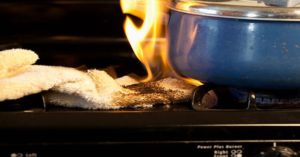In observation of Fire Prevention Week, we want to share these ways to greatly reduce your chances of a fire happening in your home.
Fire is one of the biggest dangers in a home, and a few simple but crucial preventative measures can help you and your family greatly reduce the chances of a fire.
- Keep an eye on the kitchen. The number one cause of home fires is unattended cooking. According to the National Fire Protection Association, U.S. fire departments respond to an estimated average of 172,100 fires that start in the kitchen. That’s an average of 471 kitchen fires a day: the peak times are during November and December holidays. To help avoid kitchen fires, watch what you cook, especially deep fryers and other frying equipment. To prevent a fire from spreading, keep a fire extinguisher nearby to help contain a small fire. As an added level of precaution, keep children and pets away from stoves and ovens.
- Detect it early. Smoke detectors offer an early warning system that can give you enough time to get out the house. Make sure your home’s smoke detectors are working and placed inside and outside sleeping areas, and on each floor of your home. The U.S. Fire Administration suggests testing smoke detectors once a month and changing the batteries once a year. Better yet, have a professional system installed and monitored and you won’t have to worry about the batteries getting low.
- Stay safe if you smoke. It’s the leading cause of deaths in home fires. Smoldering cigarettes and ashes can easily burst into flame when they come in contact with flammable materials, like furniture and carpeting. It’s best to never smoke in the home, but if you do, make sure you put smoking materials all the way out. Never smoke in bed where you could easily fall asleep and set fire to your bed. Be especially careful with smoking on exterior balconies and open porches where 18% of all smoking-related fires start.
- Avoid using space heaters. Heating equipment is the second leading cause of death in home fires. Avoid using them if possible, but if you do use heaters, never leave them unattended while they are on. Also, plug them directly to the wall outlet. Extension cords and power strips are not meant to be used permanently – especially for heating equipment.
- Clean the laundry room. Washers and dryers are another area of the home you can keep an eye on to help prevent fires. The vast majority (92%) of laundry room fires start in the dryer, where dust, fiber and lint get trapped. It’s important to clean out the dryer lint trap every single time you use it. Also, regularly clean all vents to maintain proper ventilation. Fires can also start in a washer because of failing equipment, including wire or cable insulation, appliance casing or the drive belt. Keep your washer maintained to help avoid a fire. It’s also recommended that you only run your washer and dryer when you are home.
- Keep electrical outlets safe As you add technology, chargers and lights to your rooms, make sure you don’t overload electrical circuits. Keep a look out for a frayed cord or an outlet with too many electronic cords plugged into an outlet or extension cord. And don’t put extension cords under rugs – walking on them can cause them to fray.
- Curb sources of flame. Candles, lighters and matches can be a big temptation for kids who want to play with them. It’s recommended to replace all candles with flameless battery operated candles to keep your children (and pets) from coming in contact with open flames. Learn more about candle hazards. Keep lighters and matches stored where children can’t reach.
Home fire prevention is just one important part of home fire safety. The Red Cross offers additional information about fire hazards in your home and what to do about them.
Stay Safe!!!!
Source: https://www.resideo.com/us/en/corporate/newsroom/featured-articles/2019/october/08/7-ways-to-reduce-your-chances-of-a-home-fire







